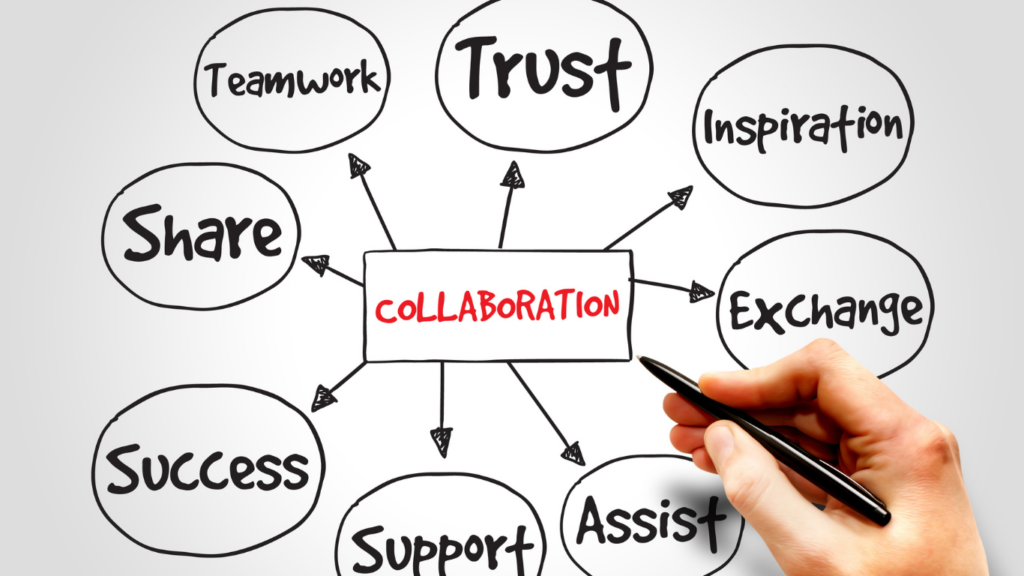Team collaboration is everything for an organization!
The opposite of team collaboration is… team competition. Team competition is a sure way to stagnate any project and any progress you need your team to make.
This article is all about how to teach and encourage team collaboration skills.
Collaboration skills: definition
Collaboration skills are the abilities that individuals possess to effectively work with others towards a common goal.
These skills include:
- communication
- problem-solving
- active listening
- the ability to compromise and negotiate
Collaboration requires each member of the team to bring their unique strengths and ideas to the table and work together to achieve a shared objective.

Collaboration skills: examples
Examples of collaboration skills include
- open communication – receive and give
- constructive feedback – receive and give
- accountability – to peers and leaders
- trust – give and get
- and respect for diverse perspectives
Collaboration skills: how to improve
To improve collaboration skills among their team, leaders like you can create a collaborative work culture, establish clear goals and expectations, encourage open and honest communication, and provide opportunities for team members to work together on projects and initiatives.
Additionally, leaders should offer their team access to training and development programs that focus on collaboration skills such as conflict management and resolution, active listening, and effective teamwork.
Providing your team with the necessary project management tools to succeed is another step in this process of improving collaboration skills.
What is the difference between team collaboration and teamwork?
Team collaboration and teamwork are closely related concepts but there is a subtle difference between the two.
Teamwork is the collective efforts of a group of individuals working towards a shared goal or objective. It involves individuals working together, coordinating their efforts, and supporting each other to achieve a common purpose. Usually, people doing teamwork together have the same skillset.
Teamwork can involve different types of activities such as brainstorming, problem-solving, decision-making, and execution.
Then team collaboration is a more specific type of teamwork that involves individuals working together to achieve a specific outcome or complete a specific task.
Team collaboration often involves individuals with different skills and expertise coming together to work on a project or problem, each providing that unique skill needed to complete the project. It involves sharing ideas, knowledge, and resources to achieve a common goal.
In other words, teamwork is a more general term that encompasses all types of collective effort towards a common goal, while team collaboration is a specific type of teamwork that emphasizes working together to achieve a specific outcome.

Define and communicate team goals
It is essential to a positive outcome to involve the entire team in the process of defining and communicating your team goals. Sharing goals with everyone ensures each person on the team understands the purpose of their work and how it fits into the company culture.
Regular team meetings provide an opportunity to discuss progress towards shared objectives and ensure that all team members are on the same page.
A common purpose fosters collaboration
Clearly defined team goals create a joint effort towards a common purpose, and this, in turn, helps to build a solid foundation for effective collaboration.
When everyone understands what they are working towards, they can focus their efforts on achieving the team’s goals and work together more efficiently.

10 Collaboration skills to develop in your team!
Here are some key collaboration skills that leaders can encourage and develop in their teams:
- Communication: This includes active listening, clear and concise messaging, and the ability to express ideas and opinions effectively. It’s important to note here that every voice should be heard!
- Trust: Building trust among team members is essential to encourage open and honest communication, idea-sharing, and constructive feedback. Building trust takes time and dedicated effort.
- Conflict resolution: Collaborating teams may encounter conflicts, and it is crucial to have the skills to resolve disagreements effectively and find solutions that work for everyone. Bringing in a facilitator can help with team conflict as they should remain neutral at all times.
- Flexibility: Being open to new ideas and approaches, and being able to adjust to changing circumstances is a valuable skill in collaborative work. This is one of the four agile values – “Responding to Change Over Following a Plan”
- Accountability: Taking responsibility for one’s actions, following through on commitments, and being reliable are essential qualities for a collaborative team. This includes being accountable to stakeholders as well as peers.
- Empathy: Understanding and respecting different perspectives, needs, and opinions of others is key to effective collaboration.
- Positive attitude: Maintaining a positive attitude, encouraging others, and celebrating team successes creates a supportive and collaborative team culture.
- Problem-solving: Being able to identify, analyze, and solve problems together is a valuable skill in collaborative work.
- Time management: Collaborative projects require effective time management skills to ensure deadlines are met, and work is completed on time.
- Creativity: Encouraging creative thinking and innovative approaches can lead to new ideas and solutions that benefit the team and the organization.
You might find you and your team need help with some or all of these. Start by prioritizing this list and work on one skill at a time!
What are the 3 crucial skills in team collaboration?
Long-term success for innovative teams is not achieved overnight. Collaborative skills help members gather and prevent roadblocks. While earlier we talked about the 10 skills teams should be developing within, here are three collaborative skills that make teams great:
- Communication: Effective communication is key to ensure that team members understand each other’s ideas and perspectives. It involves active listening, sharing thoughts and ideas clearly, asking questions, and providing feedback.
- Trust: Trust is vital for creating a safe and supportive team environment. When team members trust each other, they are more likely to be open and honest, share ideas freely, and work together towards a common goal.
- Problem-solving: Collaborative projects often involve overcoming obstacles and finding solutions to complex problems. Strong problem-solving skills involve breaking down problems into manageable parts, identifying potential solutions, and working collaboratively to find the best course of action.
These skills are interconnected, and each one can help reinforce the others.
For example, good communication skills can build trust, which, in turn, can enhance problem-solving efforts.
Ultimately, a combination of these skills can lead to a more productive and successful collaborative team.

Fostering collaboration as a value
Fostering collaboration as a value is a critical aspect of building a collaborative team culture.
Leaders can encourage this by promoting the idea that collaboration is essential to achieve shared goals and values.
Emphasizing the importance of collaboration in team meetings, performance evaluations, and other communication channels can help to reinforce its value.
Additionally, leaders can model collaborative behavior by working closely with team members, seeking input and feedback, and demonstrating a willingness to compromise and adapt.
Fostering collaboration skills
Creating a collaborative work environment involves setting up a structure that encourages teamwork and collaboration, such as project-based work, cross-functional teams, and knowledge-sharing platforms.
When collaboration is embedded as a core value, team members are more likely to work together, share knowledge and skills, and support each other, leading to a more productive and effective team.
Why leaders should highlight successful teamwork
Leaders should highlight successful teamwork because it reinforces the importance of collaboration and celebrates the achievements of the team.
Recognizing and acknowledging the success of the team can boost morale and motivation, leading to increased productivity and a positive team culture.
Highlighting successful teamwork can help to identify the strategies, processes, and skills that contributed to the team’s success, providing valuable insights for future projects.
Leaders can highlight successful teamwork through various means, such as public recognition, awards, or team celebrations.
Sharing success stories with other teams within the organization can also promote the importance of collaboration and inspire other teams to work together effectively.
Ultimately, highlighting successful teamwork can foster a sense of pride and accomplishment within the other team member, strengthen their bonds, and motivate them to continue working collaboratively towards future goals.
Encourage open communication…
And say that to your team!
Collaboration occurs in situations where team members feel they can bring themselves to the job. It should be encouraged for everyone to contribute and communicate.
Instead of letting go or controlling their emotions, they are free to be themselves bringing all of their ideas into being.
However, open communication does sometimes mean disagreement. A dispute shouldn’t hinder good teamwork.
The importance of constructive discussion and healthy disagreement are essential for facilitating a productive collaboration and positive work environment.

Good team collaboration improves employee engagement and happiness
Good team collaboration is not only beneficial for achieving business goals but also for improving employee engagement and happiness.
When employees collaborate effectively in remote teams, they feel a sense of belonging and purpose, leading to increased job satisfaction and motivation.
Collaboration allows employees to leverage their skills and knowledge, leading to a greater sense of accomplishment and contribution.
Working together towards common goals also fosters a sense of teamwork and camaraderie, building stronger relationships among team members.
Good team collaboration reduces workplace stress
Team collaboration helps reduce workplace stress by promoting open communication, shared accountability, and a sense of support among team members.
When employees feel valued and supported, they are more likely to be engaged, productive, and happy in their work.
Overall, good team collaboration is a key factor in creating a positive work environment, where employees feel valued, connected, and motivated to contribute to the team’s success.

Establish common objectives for team members
As a leader, one of the most important steps to take to foster better team collaboration is to establish common objectives for team members.
By setting clear goals that everyone can work towards, you can ensure that everyone is aligned and focused on the same priorities.
To establish these common objectives, we work closely with all team members to define your overall vision and then break it down into specific goals and milestones.
This helps you to identify key areas of focus and track your progress towards achieving them.
Everyone on the team should have a clear understanding of their role and how it contributes to the overall objectives. This helps to build a sense of accountability and ownership, encouraging everyone to work together towards our shared goals.
By establishing common objectives for team members, you are able to foster collaboration and teamwork, as everyone is working together towards a common purpose.
This not only improves your productivity and efficiency but also helps to build a stronger sense of camaraderie and shared accomplishment among the team.
Lead by example
Do you find it difficult to build productive teams and diverse teams? Could it be you lack some important collaborative leadership skills? If that’s the case, you’ll want to start your own learning journey.
Why?
Because collaboration commences at the top. Make sure team leaders and you are always encouraging co-creating openly and have plenty of room for creativity proper communication and collaboration.
Encourage your team members to contact you to get their questions answered.

How to build time for team bonding
Building time for team bonding is important for fostering collaboration, strengthening relationships, and promoting team morale. Here are some strategies that leaders can use to build time for team bonding:
- Schedule regular team-building activities: Set aside time on a regular basis, such as once a month, to engage in team-building activities, such as group outings or team lunches.
- Plan team-building events: Organize team-building events, such as volunteer opportunities, off-site retreats, or team-building workshops, to provide opportunities for team members to connect and collaborate.
- Incorporate team-building into work activities: Build team bonding into daily work activities, such as regular check-ins, project kick-offs, or team huddles.
- Encourage team socialization: Encourage team members to socialize and get to know each other outside of work, such as by organizing after-work events or happy hours.
- Lead by example: As a leader, model the importance of team bonding by participating in team-building activities and encouraging others to do the same.
By building time for team bonding, leaders can strengthen relationships among team members, foster collaboration, promote their collaboration skills, and create a more positive work environment.

Stop ineffective and ill-prepared team meetings
Ineffective and ill-prepared team meetings can be a waste of time and hinder team collaboration. To avoid meetings that are a waste of everyone’s time, leaders can take the following steps:
- Set clear objectives: Before scheduling a meeting, set clear objectives and communicate them to all team members. This will help everyone understand the purpose of the meeting and come prepared.
- Prepare an agenda: Create a detailed agenda and share it with all team members in advance. This will help ensure that everyone is prepared and that the meeting stays focused.
- Invite the right people: Only invite team members who need to be there. This will help ensure that the meeting is productive and that everyone’s time is respected.
- Start and end on time: Respect everyone’s time by starting and ending the meeting on time. This will help demonstrate that the meeting is important and that everyone’s time is valued.
- Encourage participation: Encourage everyone to participate and share their ideas during the meeting. This will help ensure that everyone’s perspective is heard and that the meeting is productive.
By taking these steps, leaders can ensure that team meetings are productive and effective, and help foster collaboration among team members.

Highlight successful teamwork
Everyone enjoys being recognized and the recognition that reflects the efforts of the entire team and members.
If two people collaborate to bring their ideas same business goals to life, give them equal participation and credit for the particular challenge they are faced with. It will give them the opportunity to shine in the spotlight and may also be an example of future collaboration between other teams.
6 Key values of collaborative teams
Collaborative teams are built on several key values that promote effective collaboration and drive success. These values include:
- Trust: Team members must trust each other, have faith in each other’s skills and abilities, and feel confident in their collective success.
- Respect: Collaborative teams must be built on mutual respect, recognizing and valuing each other’s contributions and perspectives.
- Open communication: Effective collaboration requires open communication, with team members sharing their ideas, feedback, and concerns freely and honestly.
- Flexibility: Collaborative teams must be adaptable and flexible, willing to pivot, and adjust as needed to changing circumstances and evolving goals.
- Accountability: Team members must hold themselves and each other accountable for their actions, taking ownership of their work and its outcomes.
- Collaboration: Effective collaboration involves working together towards shared goals, leveraging each other’s strengths and resources to achieve better outcomes.
By embracing these values, building collaborative teams that can foster a culture of collaboration, innovation, and success, where team members feel valued, supported, and motivated to work towards common goals.

Celebrate and reward successful teamwork
Celebrating and rewarding successful teamwork is a powerful way to reinforce the value of collaboration and encourage ongoing collaboration among team members.
When team members are recognized for their contributions and successes, it creates a sense of pride and accomplishment, strengthening their commitment to the team and its goals.
Leaders can celebrate teamwork in various ways, such as highlighting successful projects during team meetings, recognizing team members’ contributions in company-wide communications, or providing incentives or bonuses for successful team outcomes.
By celebrating collaborative behaviors and rewarding teamwork and team performance, leaders can reinforce the importance of collaboration and motivate team members to continue working together towards shared goals.
Promote a community working environment
Collaboration is essential in fostering an open-minded working environment. A team member feels more connected and valued when the company leadership has an interest in their job.
You shouldn’t overwhelm a team with endless meeting times or insist on working in collaboration.
Want to learn more to reignite your meetings and make them a place of successful team collaboration, even if your team is a remote team? Read this resource guide to get started.
How to assure alignment across distributed teams
Assuring alignment across distributed teams can be challenging, but there are several strategies that leaders can use to promote collaboration and communication.
First, it’s important to establish clear goals and objectives for the team, ensuring that everyone understands the team’s mission and how their work contributes to its success.
Leaders should encourage regular check-ins and updates, using video conferencing and other communication tools to facilitate real-time discussions and collaboration.
Team members should also have access to shared documents and other resources, ensuring that everyone has access to the same information and can collaborate effectively.
Another effective strategy is to establish clear roles and responsibilities, ensuring that team members understand their individual and collective responsibilities and how their work contributes to the team’s success.
Finally, it’s important to foster a culture of open communication and feedback, encouraging team members to share their ideas, concerns, and challenges.
By implementing these strategies, leaders can ensure alignment across distributed teams, promoting collaboration, innovation, and better outcomes.
What does effective collaboration look like?
Effective collaboration is characterized by a shared sense of purpose, mutual respect, and open communication among team members.
It involves working towards a common goal, pooling resources, and leveraging each other’s strengths to achieve better outcomes.
Effective collaboration also requires active listening, constructive feedback, and a willingness to compromise and adapt. Successful collaboration involves setting clear expectations, establishing common goals and timelines, and ensuring that everyone has the resources and support they need to contribute effectively.
In a collaborative environment, team members are empowered to take ownership of their work, contribute their unique perspectives, and hold each other accountable for their actions.
Ultimately, effective collaboration leads to better decision-making, increased innovation, and improved outcomes, benefiting both each team member and the organization as a whole.
Good team collaboration supports knowledge sharing
Shared knowledge among team members is a critical aspect of effective team collaboration.
By sharing knowledge, team members can learn from each other, build on each other’s strengths, and develop a deeper understanding of the project or task at hand.
This can be especially important when working on complex or technical projects that require specific expertise.
During team gatherings and meetings, you’ll be able to share ideas and experiences with one another. Therefore, teamwork provides the ability to gain more knowledge from colleagues.
In exchange for the knowledge they gained, this is an opportunity for team members to learn more about each other.
By sharing knowledge, team members can avoid duplicating work, reduce errors, and develop more innovative solutions. Additionally, shared knowledge promotes a culture of continuous learning, as team members are encouraged to seek out new ideas and perspectives.
This can help to boost morale and motivation, as team members feel that their contributions are valued and that they are part of a collaborative and supportive team culture. Leaders can encourage shared knowledge among team members by creating opportunities for knowledge sharing, such as regular team meetings, peer-to-peer mentoring, and training sessions.
By modeling collaborative behavior and promoting shared knowledge, leaders can help their teams develop a more comprehensive understanding of their work, achieve better outcomes, and foster a culture of collaboration and learning.

Team collaboration makes organizations more connected
Team collaboration plays a crucial role in making organizations more connected.
When employees collaborate effectively, they are better able to share information and ideas, which leads to greater transparency and communication within the organization.
By working together towards common goals, teams can break down silos and build stronger connections across departments and functions.
This not only improves the flow of information but also helps to build a culture of trust and collaboration throughout the organization.
Team collaboration helps build a sense of purpose
Collaboration also helps to build a shared sense of purpose and direction, aligning everyone towards the same vision and goals.
This creates a more cohesive and connected organization, where employees feel that they are part of something larger and more meaningful.
Overall, team collaboration is a powerful tool for building stronger connections and fostering a sense of unity within organizations.
By encouraging collaboration and teamwork, organizations can improve communication, build trust, and create a more connected and engaged workforce.
Good team collaboration improves employee engagement and happiness
In a more collaborative culture and team, it’s crucial that everyone maintains a high spirit. And if your team has freedom of expression, then company culture in your workplace will be much healthier too.
When working for an employer, a person is happy with his or her work environment so it is possible that he can remain in that position longer.

Why team collaboration matters
Shared knowledge among team members is a critical aspect of effective team collaboration.
Team members can learn from each other, build on each other’s strengths, and develop a deeper understanding of the project or task at hand.
Shared knowledge is especially important when working on complex or technical projects that require specific expertise.
By sharing knowledge, team members can avoid duplicating work, reduce errors, and develop more innovative and better solutions together.
Long-term benefits of learning team collaboration skills
Shared knowledge promotes a culture of continuous learning, as team members are encouraged to seek out new ideas and perspectives.
This can help to boost morale and motivation, as team members feel that their contributions are valued and that they are part of a collaborative and supportive team culture.
Leaders can encourage shared knowledge among team members by creating opportunities for knowledge sharing, such as regular team meetings, peer-to-peer mentoring, and training sessions. This takes facilitation skills and work.
By promoting shared knowledge, leaders can help their teams develop a more comprehensive understanding of their work, achieve better outcomes, and foster a culture of collaboration and learning.

What if you have slow results?
Problem: Team performances are not improved and group dynamics do not seem to have remained unchanged. Or maybe you don’t know how to improve the work environment at work in your company.
Solution: Increasing Teamwork isn’t something you get instantaneously. It is also important to get visibility in your organization.
Try to set measurable and specific goals to get there and stay focused to see if it is progressing.
Some teams will face the same problems when they are together, but whoever you’re leading is more likely to succeed in overcoming these difficulties.
The complexity of decision-making
Collaboration is based on common sense and a shared vision for collective work. In many cases finding this consensus requires many different perspectives and backgrounds.
In fact, decisions in workplace collaboration may become difficult and even violent when the hierarchy isn’t followed.
This scenario could slow the work and complicate interpersonal interactions and established relationships between colleagues.

Avoid information overload
It has already been shown that improved information sharing can improve collaboration among colleagues across professional fields of expertise.
Ideal for organizations that provide greater clarity and connection between different components.
However, in a more challenging situation, additional details could overwhelm individual team members or the course of the collaborative effort. Then there are:
Team collaboration skills increase engagement
Active workplace collaboration helps people to be engaged workforce and become more involved with the company’s overall mission in terms of work and its goals.
Global Workplace Report 2020 shows how collaboration with others contributes significantly to employees feeling engaged. In contrast, employees who work primarily independently tend not to have full engagement with a company in any way.
Engaging employees are much more involved and committed to the organization’s success, and success and more inclined to contribute.
Increasing teamwork results in increased employee satisfaction and consequently lower severance rates for employees.

How to get your team started by learning team collaboration skills
Most likely this is a task you want to outsource to a professional leadership coach who has experience in teaching effective communication skills to your entire team and has a model for leadership success for you.
If you are ready to work and build your own model for leading change, you can start today!

